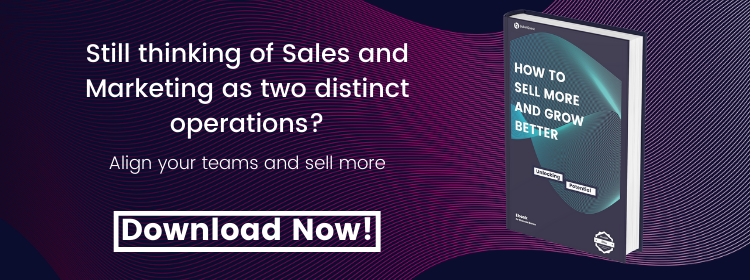Creating a strategy is rarely simple, never mind when you've a sales team to manage. In this article, discover how to build a sales enablement strategy in six simple steps.
In work as in life, most of us can admit to wanting to better ourselves. Leading the sales team, this typically means enabling your reps to sell more, close deals faster, and build stronger, more meaningful relationships with your prospects and customers.
When this doesn’t quite work out as planned, many of us can be quick to lay blame on our teams. Less common — but fundamental to sales success — is a long, hard look in the mirror. Are we driving the right behaviour? Are we giving the right direction? Are we incentivising the team in the right way? And crucially, can we provide ourselves with objective examples for each?
You can’t work any harder than you already are, but you can work smarter.
A SMART approach to sales enablement involves creating a sales strategy plan around six key elements. These are the areas of your sales strategy that will enable you to maximise the impact of your team’s activities and, ultimately, close more business:
- Reporting — This should be meaningful, clear, and timely, enabling you to make better decisions
- Process — Define the map to measurable, repeatable success that you can scale
- Systems — Drive the behaviour that consistently follows the process map
- Technology — Increase productivity with automation that removes the burden of administration activities
- Content — Support and advance each sale with messages that help the buyer
- Training — Build skills and coach individuals to maintain peak performance
To discover how to build a successful sales enablement strategy, let’s look at these six areas in more detail.
How to build a sales enablement strategy in 6 key steps
1. Review your goals and how your team is reporting on them
The KPIs you might use to measure your team’s performance can include but are not limited to:
- lead to customer conversion rate
- lead to opportunity conversion rate
- opportunity to customer conversion rate
- salesperson closing rate
- team closing rate
- ROI (based on cost of acquisition: lifetime value)
Similarly, you might consider reporting on KPIs at the following intervals:
- Live through your CRM
- Week on week
- Month on month
- Quarter on quarter
- Year on year
2. Review the existing sales process
Review and refine your documented sales process, seeking opportunities to optimise it with new skills, technology, and expertise. Consider reviewing the sales process monthly and quarterly as it becomes more robust.
Support the sales process with automation workflows and required fields to ensure deals are progressed with the right information in place. Create data points and dashboard reports in your CRM to track compliance with the process, sales outcomes and reasons.
Ensure that individuals, teams, and managers understand and agree to comply with the agreed results. Define the measures of accountability with necessary teams or business units and review monthly alongside KPIs.
Related read: How to Improve Sales Productivity: Process and People
3. Review your systems
The system is the way your team operates with the process. It's the 'who does what' part. You will want to set up systems for measuring and reporting on KPIs, tracking compliance with the process, prospecting, creating an opportunity, following up, qualifying, and closing.
You may also need to implement systems for lead scoring, auditing, organising content, creating consistent messaging and value propositions, testing, and incremental improvement.
One good way to bring this to life with the sales team is a commitment to 'no lead left behind'. Everything should be followed up until it's closed or qualified out.
Collated, the systems can form a part of the SLA between sales and marketing, helping to reinforce accountability and drive the right behaviour.
4. Review your sales technology
Integrate your process and systems with technology tools that increase productivity and provide data for KPI reporting and decision-making.
You already know how important technology is for enabling your team. The data speaks for itself: our HubSpot CRM: Best Practices and Pro Tips article is one of the most popular reads on the blog. Whichever technology solutions you’re researching and investing in, implement them in line with best practice to ensure your team can put them to best use across the sales process.
5. Review how your team is using sales content
The inbound sales methodology champions your use of articles, case studies, data sheets, and more to help your prospect feel informed and enabled about their purchasing decisions.
This includes both internal documentation and assets for your team to share with prospects. Determine the best use of existing sales content and review marketing content for opportunities where it could be optimised to work within the sales process, as well as identifying any new content requirements.
6. Define appropriate training and coaching plans
Coaching can empower your salespeople to act with more confidence and efficiency. In the long-term, this leads to a stronger, more independent sales team capable of running with less-frequent, top-level management. Yet only three percent of managers are spending at least 50% of their time on this influential and impactful process.
As they’re hands-on with it every day, salespeople typically take to new technology quickly, but often they will still need support with process, review, self-improvement, forecasting, and deal qualification.
Learn about the sales enablement boot camp that turns your lowest performers into sales superstars.
Leading from the top with a successful sales plan
It's crucially important that sales leaders understand their accountability to the SLA and their role in driving the successful enablement of the sales organisation.
The idea of short-term issues and long-term issues isn’t just restricted to the challenges your sales team might be facing — or even the kinds of fixes you implement. The need to act now vs. the need to plan for the future is a conflict we often see in many of the managers and directors we meet when implementing sales enablement services for our clients.
To put it another way, you recognise the need for you and your salespeople to act with speed, engage with leads while they are still hot, and close deals as quickly as possible. But you also understand that for your sales team to thrive, it needs to demonstrate long-term, predictable revenue growth. This means planning.
The sales director who prioritises one over the other may well find themselves in a situation where they can’t close the immediate business they need or they can’t grow beyond a certain size, limited by their existing team, process, and systems.
The name of the game here is finding a balance, overcoming any natural inclinations you feel towards acting or planning in order to spend an appropriate amount of time on both.
What does this look like in your business, and what role do you and your senior team play in maintaining the status quo — both short-term and in the long run?
To learn more about effective sales strategies and how to make sure your team is closing as much business as possible, download our specialist sales ebook now.
Heading
Separated they live in Bookmarksgrove right at the coast of the famous Semantics, large language ocean and many more stuff and more more more


A recovering salesperson, now turned consultant. I implement HubSpot for organisations, do clever things with HubSpot reporting and help sales teams become more productive.



.png?width=50)

.png?width=50)
.png?width=50)



































